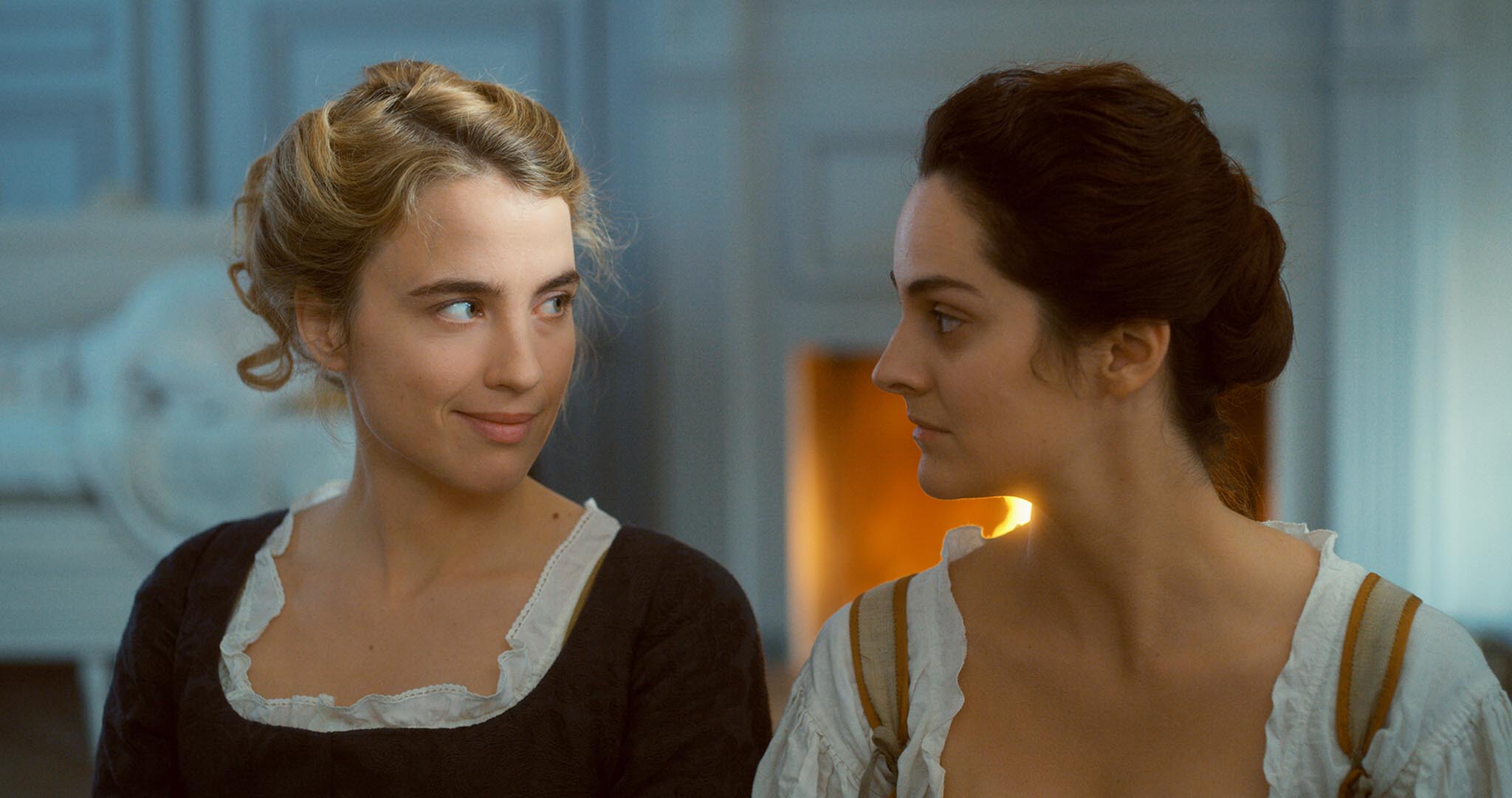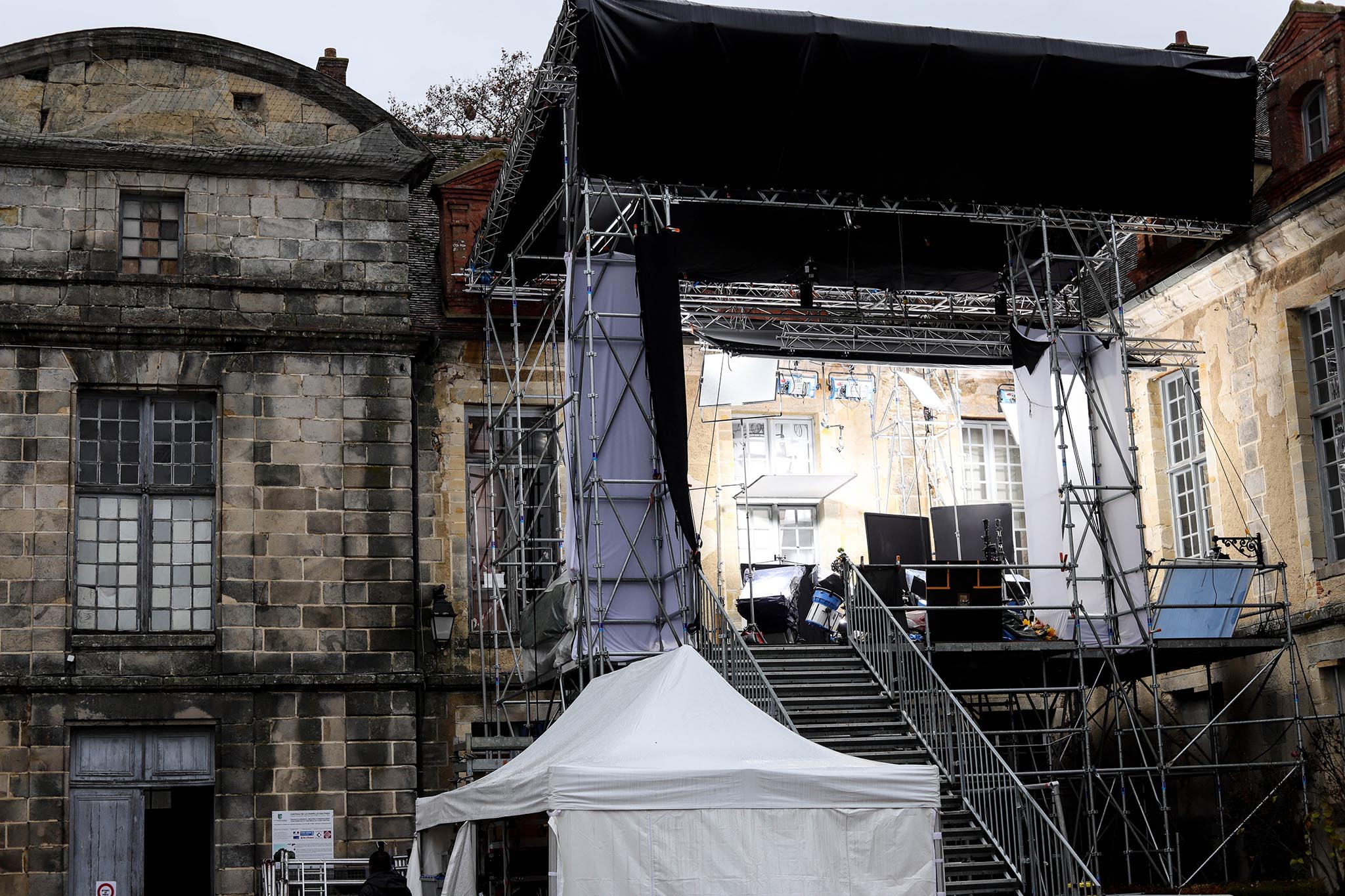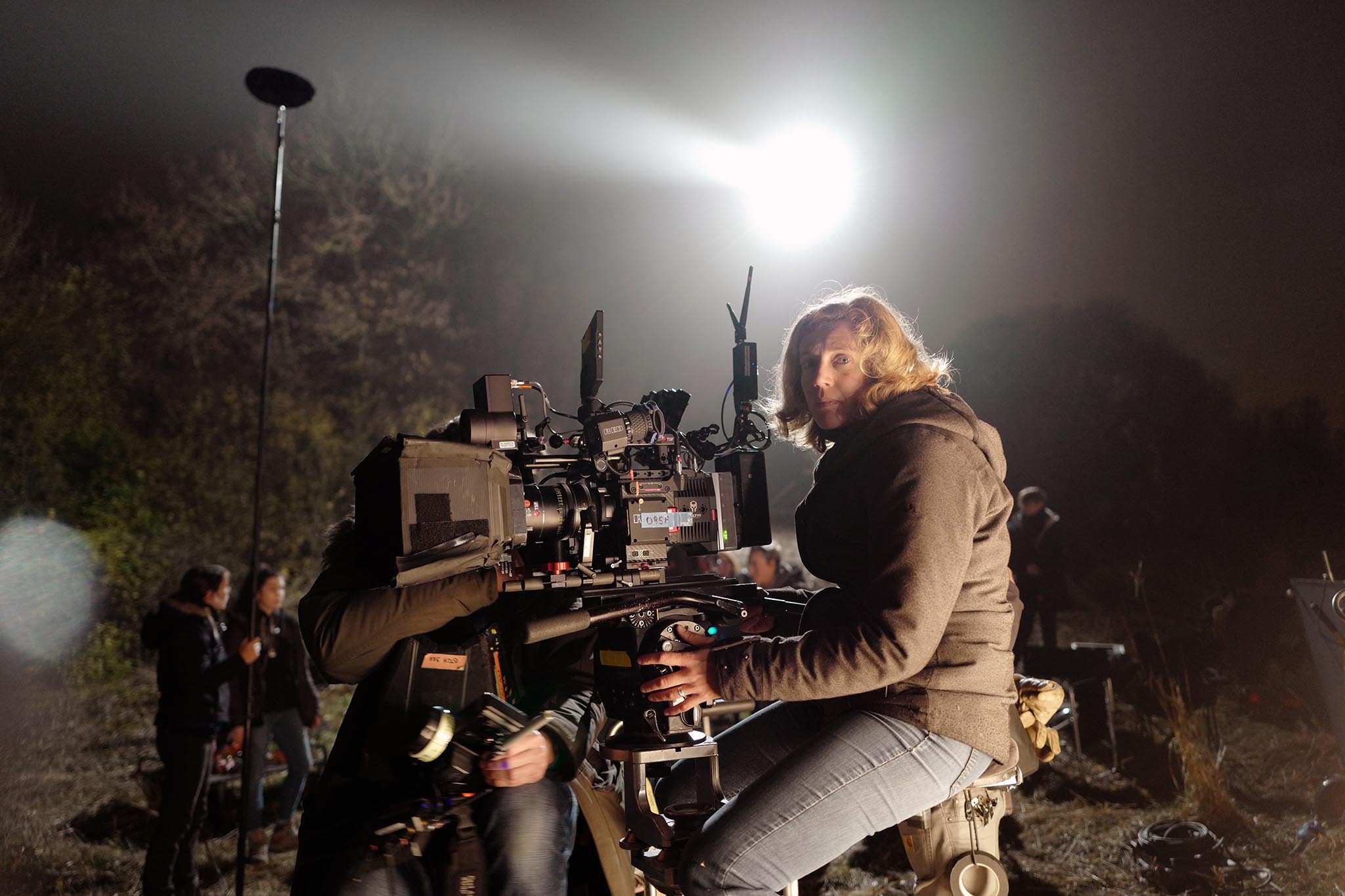
Claire Mathon, AFC. Photo by Ariane Damain Vergallo. RED MONSTRO 8K VV, Leitz THALIA 65mm T2.6, Teradek Bolt, OConnor head. A Preston Light Ranger 2 was used on the night scenes.
The Cannes Film Festival would normally be running right now.
Portrait of a Lady on Fire premiered at Cannes last year, around this time. It is now streaming on Hulu. Céline Sciamma directed and Claire Mathon AFC was the cinematographer.
Claire Mathon graduated from the film school École nationale supérieure Louis-Lumière. She started as a camera assistant and quickly began working as a cinematographer.
Credits include L’Inconnu du lac (Stranger by the Lake, 2013, nominated for the César Award for Best Cinematography); Atlantics (2019); Raoul Taburin (2018), Les deux amis (Two Friends, 2015).
For Portrait of a Lady on Fire, Claire won the Los Angeles Film Critics Association Award for Best Cinematography and New York Film Critics Circle Award for Best Cinematographer. On FEb 28, 2020, she was awarded a César from the Académie des Arts et Techniques du Cinéma (like the French Oscars).
Here is our interview, reprinted from the Feb 2020 edition of FDTimes. Thanks to Danys Bruyere of TSF and Olivier Garcia of HD Systems for introducing us.
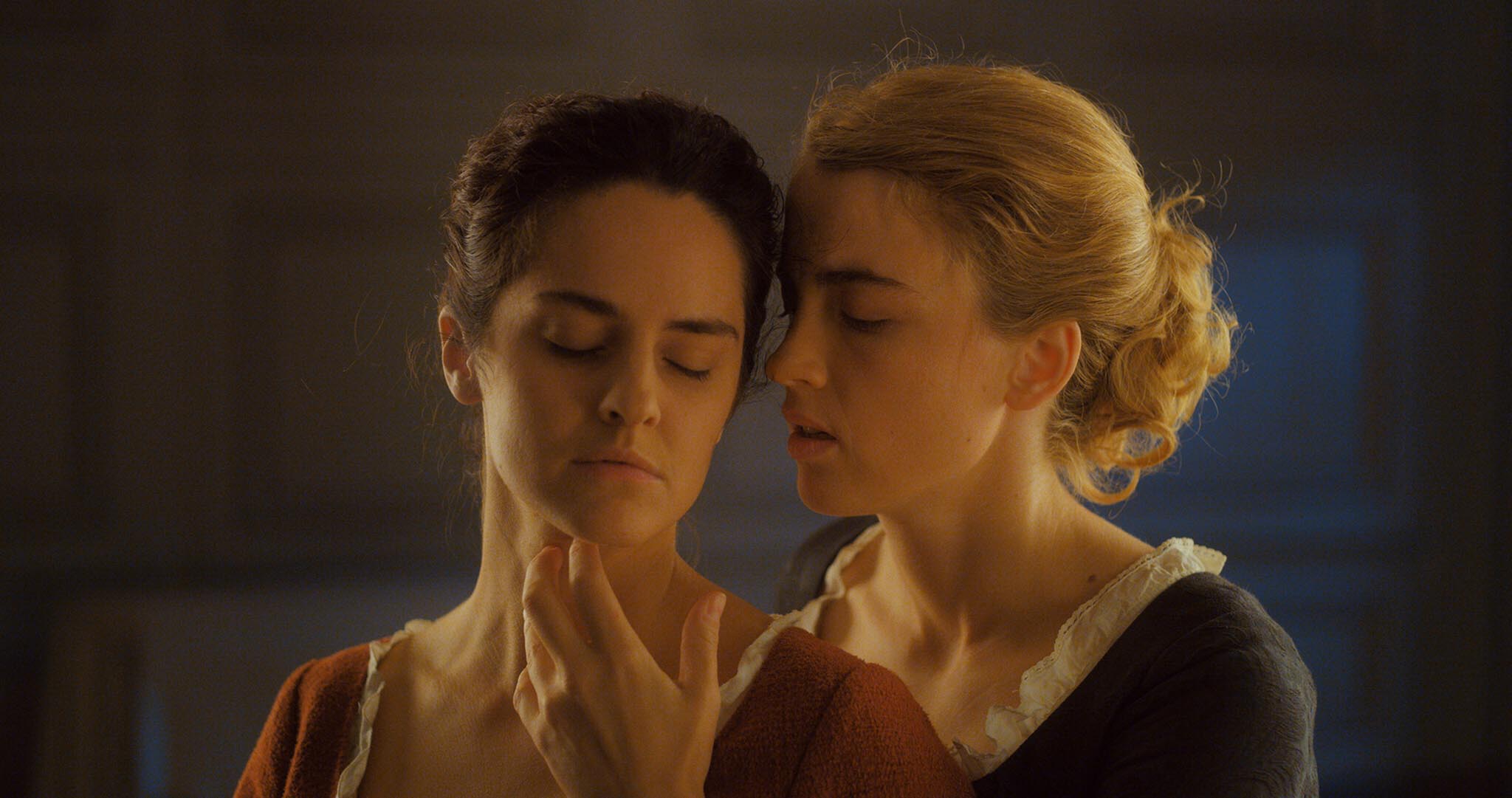
Above and below: Framegrabs from Portrait of a Lady on Fire. Noémie Merlant as Marianne (above left) and Adèle Haenel as Héloïse (above right).
Cinematography on Portrait of a Lady on Fire
by Claire Mathon AFC
The Louvre
The film takes place in the 18th century. It is the story of an artist who is commissioned to paint the wedding portrait of a young without her knowledge. Of course, we felt the need to go see paintings of the eighteenth century. But we were not looking for direct references, nor to imitate a particular painter.
I remember one visit to the Louvre where we mainly looked at the textures, the material, the touch and the precision of the renderings. Our pictorial inspirations were not limited to eighteenth century painting. For my part, I was struck by the rich colors, in daytime and at night, and the nuances that were very present.
The Look
We had to find the balance between life and the timelessness of skin tones. Staying true to the era while keeping up with the precision of contemporary exigencies led me to choose the RED MONSTRO 8K VV camera with Leitz THALIA lenses. The Large Format sensor was chosen for its perspectives and for the depth it gives to the image. It contributes to the feeling of being immersed in the scene. From the beginning, we talked about incarnation, of this strong presence that we wanted to give to the faces. I also liked the pictorial dimension of the RED MONSTRO combined with THALIA lenses and how they rendered colors, which brought a lot of precision and modeling to the faces. I also chose them for the rendering of the flames and candles.
The richness of the shades of color in the faces that we first filmed during the day exteriors, and the precision without harshness encouraged me choose the MONSTRO / THALIA combination. The softness, the shape and this slightly satiny finish are also the result of a combination of the light quality, makeup, SATIN filters and post-production. We also sought to minimize flares as much as possible in situations with strong backlight.
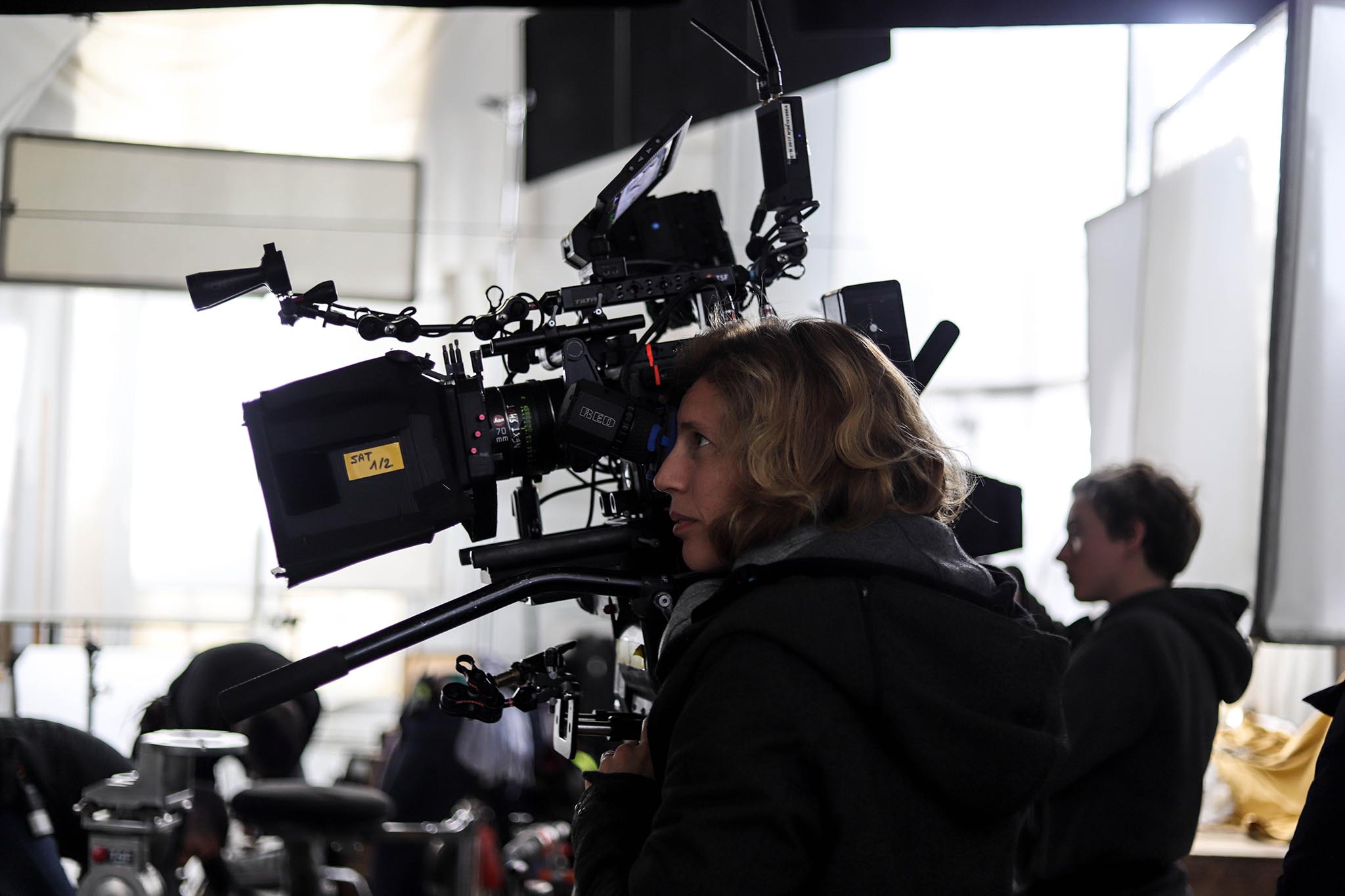
Claire Mathon, AFC. Day interior. A Cinematography Electronics CineTape was used on most daytime shots.
Photo by Margaux de Paint Preuve.
RED MONSTRO 8K VV
In April 2018, I had the chance to participate in tests initiated by TSF around large sensor cameras (ALEXA 65, VENICE and MONSTRO 8K VV cameras). Testing gave me a chance to discuss with other colleagues the specifics of these new cameras. At the very first tests for Portrait of a Lady on Fire, we wanted to see 35mm images and digital images. I chose the RED MONSTRO 8K VV for these tests, convinced that the large sensor would bring the desired presence to these portraits. Its texture and color rendering, which I really like, also reminds me of 35mm film.
With Céline, we chose the RED MONSTRO for the actual resonance it gave to this film, combining memories and period films. We were talking about re-inventing and enhancing our 18th century image to current realities.
We shot in 7K, using 8K as a reserve to be able to stabilize the image when it became necessary in post production.
After several series of tests, we established, with the color grader Jérôme Bigueur at Hiventy laboratory, two LUTS. One LUT was for day and the other for night, and these LUTs that we visualized on the set were used for the rushes. I did not have a DIT. Throughout the shoot, Jérôme oversaw the rushes and sent me framegrabs that allowed me to react daily and thus get as close as possible to my visual intentions.
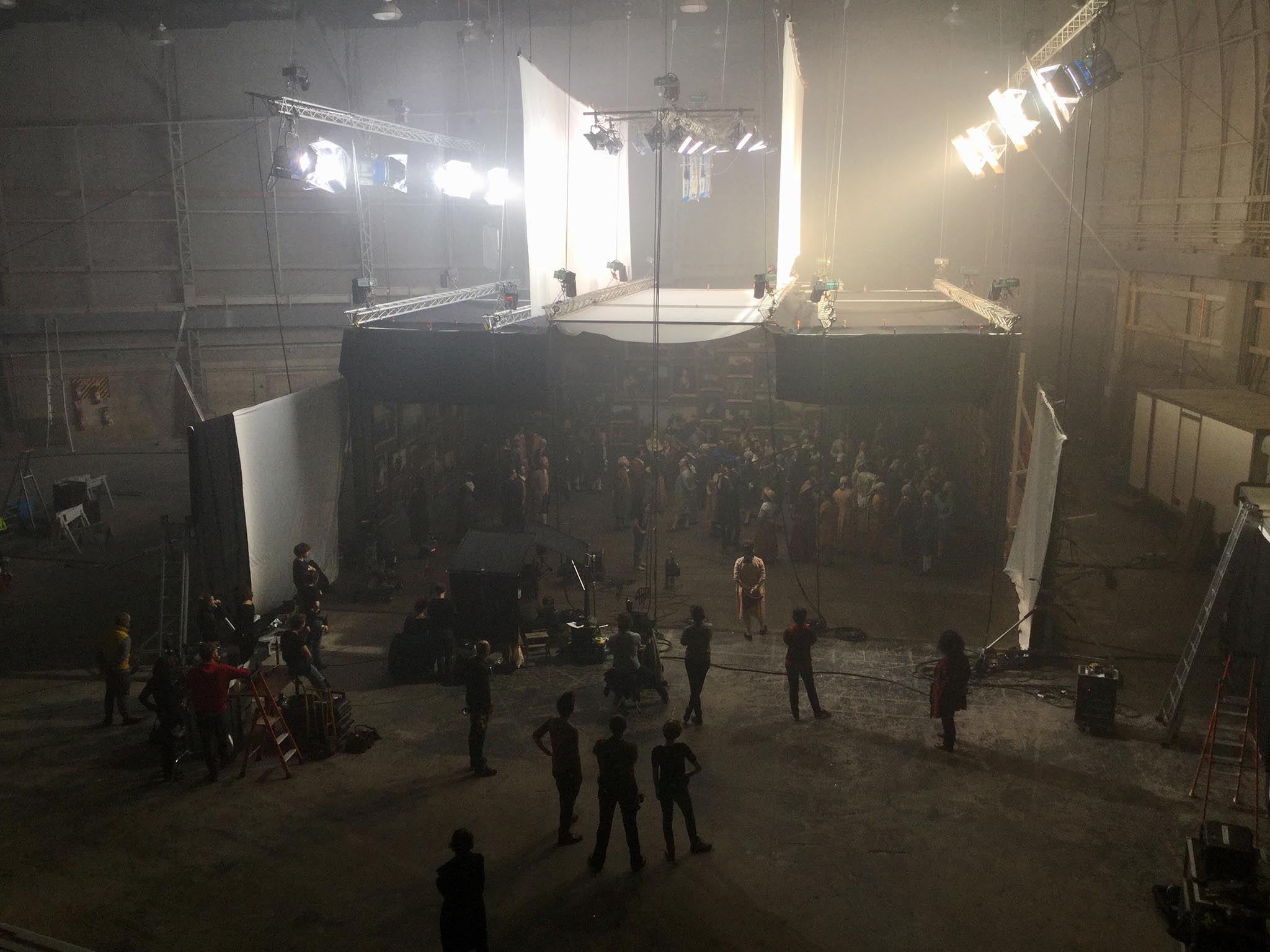
Claire Mathon describes the Epinay studio lighting: “ARRIMAX M90 (9K), Maxi 9 fixtures and Ruby Seven accompanied by 20x SkyPanels S60 and 2x S60 to recreate the daylight entering the glass windows in the set of the Studio. We recreated a color difference with the cooler north side having
light that is diffused by a large white muslin and the south side with the additional passage of warm light.” Photo: Ernesto Giolitti.
Leitz THALIA Primes
I never compensated for the different maximum apertures of the THALIA Primes (from T2.6 to T2.9) with the ISO sensitivity of the camera. After testing with other optics, I definitely liked the rendering of the flames at this aperture and ISO sensitivity. This constraint pushed me to illuminate, to highlight the faces whatever their locations and that was the line to follow for this film. Lighting by zones also allowed me to keep contrast in the image without adding contrast to the faces.
The THALIA 70mm T2.6 Prime was one of our favorite focal lengths to capture this film about the looks and the proximity of these women.
Flames and candles
Once the camera and lenses were chosen, I was lucky enough to be able to perform several series of wardrobe tests (the green dress) with the paint, the candles, and the smoke and to then select the filters, the materials and the sources that we would use at night.
For the candle light, I did not want to be too realistic, to be too subjugated to candles even if we had to, of course, believe in how this light would have appeared in that epoch.
I kept the idea of obscurity, of mystery, without necessarily respecting the directions of the light sources. I’ve been looking for the right warmth, the right color for a long time. Despite the warmth of the light, I wanted to keep a richness in the colors, especially for the painting and the skin tones. This issue of color at night was the most difficult thing to calibrate.
From the first attempts, Céline and I felt our desire for purity encouraged us, as much as possible, to move the candles (or their accessories) offscreen. Another challenge was the movement of the light, the flicker of the flames, which we tried to minimize as much as possible.
I liked it when the light from the candles was the result of a mix of various sources, like candles installed in 2K blond (Ianiro open face style) fixtures with their lamps removed, 2000 K Ribbon LEDs (from Softlight in Paris) and Ropelights (small tungsten bulbs installed in flexible plastic tubes. The complexity of the shots sequences often required that several light sources be used simultaneously during the shot.

Photo #1 and #2 (above)
Exterior view of castle.
SkyPanels aimed from above directly through windows. ARRIMAX and Maxibrute 9 fixtures bouncing onto reflectors, mirrors or white fabric to recreate daylight in the workshop of the castle (the place where Marianne paints the portraits of Héloïse).
Photos: Margaux de Paint Preuve
Lighting
It is a film of portraits, of faces. We had to erase the raw and contemporary look of the faces in order to capture the variations, the slightest trembling, to reveal their redness, to feel their emotions without ever letting the light take over. I tried to de-emphasize the light’s directionality by working on an all-encompassing softness.
The film was shot in natural locations which also made it possible to use a wealth of discoveries. Natural light greatly influences my work. I like its subtle mixtures of color and its ever-changing reflections, but in this case it was necessary to hold on to its softness, its modeling in the skin tones—as if the light emanated from their faces.
We shot all the exterior scenes at the beginning of the film in Brittany, and then at a castle in Seine-et-Marne. It was an 18th century castle had not been inhabited or restored in many years. Its woodwork, colors, and parquet floors were frozen in time.
Our Production Designer Thomas Grezaud worked with great finesse to respect the existing materials and the purity of the décor.
Because of the castle’s size and the workshop’s location on the 1st floor (with windows that were 8 meters above the courtyard side and 16 meters above the moat side), it was difficult and expensive to light the interiors from outside. And of course there were constraints due to its status as a historical monument. Neverthelss, all the lighting in the workshop is artificial.
I had the gaffer and key grip build a large structure on one side that allowed us to control the lighting and change it according to the different scenes. The lighting fixtures were often controlled through DMX via an iPad. During the pre-light, I also had the art department manufacture sets of frames (tailor-made for each window) fitted with different densities of NDs and scrims.
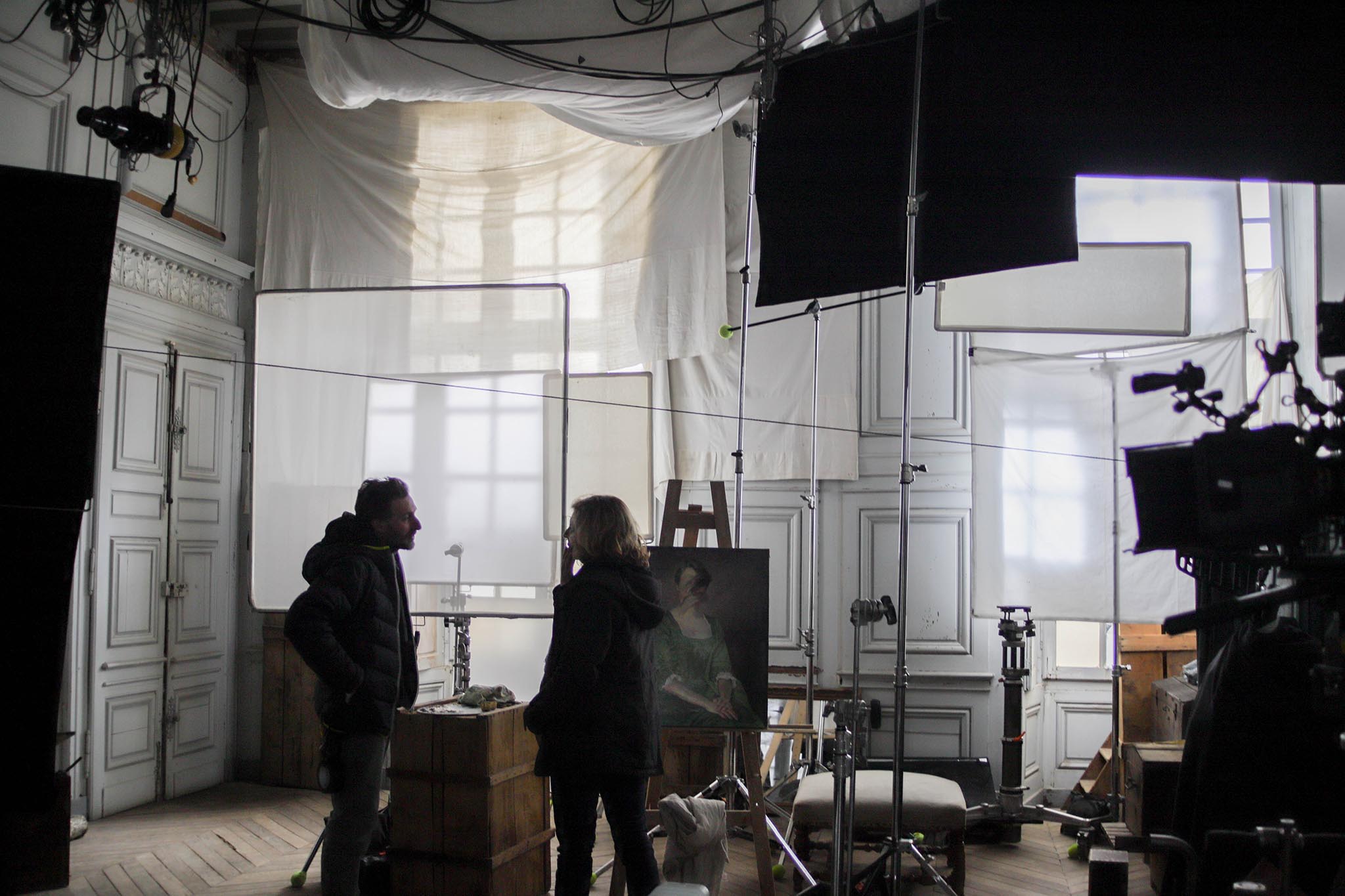
Claire Mathon AFC in discussion with gaffer Ernesto Giolitti. Interior of workshop in the castle.
This is the reverse of photos #1 and #2. NDs and scrims are on the windows in the areas that will be behind the actress.
I mostly lit from the outside and reworked the light on the inside with many diffusion frames and flags. The large number of the setups and filming in late autumn forced me not to rely on ambient light. Photo #1 and 2 show the exterior lighting plan. Photo #3 shows the effect inside the location: artificial light coming in through the large windows of the workshop. At this time of the year, the sun did not come in through the castle windows at all.
Camera moves
Director Céline Sciamma’s staging is very precise, very choreographed. It was important to reveal the simplicity of movement, their daily intimacy. It’s a film about the look. In order to display the exchange of glances and the strength of the attraction between the two women, we were led to set up many subjective tracking shots with a Dolly or Steadicam. It was exciting to look for the right distance, the right composition and rhythm to give life to this camera of ours that watches, that scrutinizes.
The precision of the movements that Céline wanted urged us to choose the Peewee 4 Dolly from Chapman. The work on the gaze, and the need to embody this gaze, to make it sensitive and vibrant, went in the direction of centering the scene as much as possible in the eyepiece. Hence the choice, for example, for the end shot at the theater, of the GF8 X-TEN crane from GFM. I had a lot of fun doing both the framing and the lighting, experiencing the scenes and feeling how the light lives on the faces of the actresses.
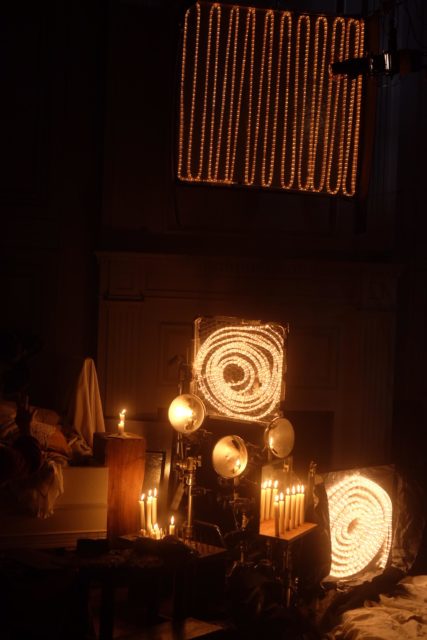
Rope light. “We created frames of different sizes with these garlands. They allowed us to combine the brightness of small bulbs and to be able to work with fairly large sources.” — Claire Mathon, AFC.
Focus / depth of field
Putting the two characters in the same shot was important and part of the desire for equality between them. It was necessary to find the positions and the depth of field that included them as naturally as possible. Of course, I shot the majority of the night sequences wide open at T2.6 to T2.9. This resulted in a very shallow depth of field and that led us to consider the Preston Light Ranger 2 during the camera tests and then to rent it for 10 days of shooting.
Technique and technology and style
I like to look for the most appropriate tools for each project. I find it necessary to experiment, question and change the choice of the camera, the optics and the tools, which allows me to invent the images that seem to be the most appropriate for each film.

